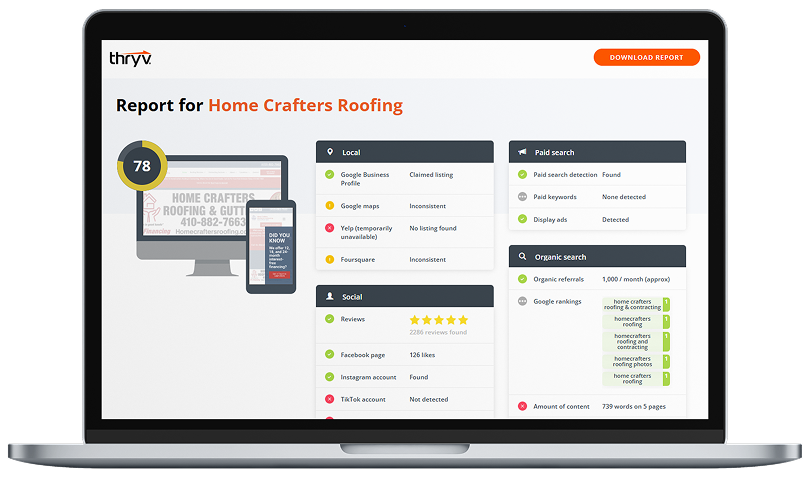It’s easy to get caught up in running your business. Billing and sales keep the power on, but it’s important to prioritize growth, too.
The best way to grow your business is to analyze why you lose customers to competition. This is called a competitive analysis, and it helps you determine growth opportunities for your brand.
Free: Online Presence Scan
See how your business compares to the competition and find out what customers are saying about you.
Try NowToday, we’ll review what a competitive analysis is and show you how to conduct one for your business.
What is a competitive market analysis?
A competitive market analysis compares direct competitors in your industry and evaluates their strengths and weaknesses. It shows how your brand differs and highlights why customers choose other companies over yours. Overall, a competitive market analysis identifies what you’re doing well and where you can improve your marketing campaigns.
A market analysis is a document that stores this information. It can be formatted differently, but it should include the following sections.
Industry Overview
This section will identify your target customers and any relevant industry trends. Here’s where a buyer persona comes in handy. It lists who your ideal customers are, their ages, interests, and other information.
For example, the overview section of an HVAC company might say,
This section helps you keep customers at the forefront of your research. What are their purchasing trends? What are people spending their money on? The overview section should discuss these details.
Competitor List
Here’s where you’ll list your top competitors. These are the companies that you compare yourself to. Be sure to choose ones that have value propositions similar to yours. A value proposition is a statement that describes the unique value you provide to customers.
If you’re unsure who your top competitors are, read this guide to learn how to identify your competition.

Competitor Analysis
Now, it’s time for the analysis. Here’s where you’ll compare your company against each competitor. This section typically includes an overview of what the brand sells, how much they charge, and ways they promote it. It also features a SWOT analysis that breaks down this business’s strengths, weaknesses, opportunities, and threats. When writing this section, consider their marketing strategies, sales performance, and business resources.
Don’t forget to be honest, too. It’s okay if a competitor is outperforming you. The purpose of this exercise is to find ways to beat them. Competition is just a natural part of business.
Positioning Statement
The positioning statement is your big takeaway. It explains how you’ll promote your business against this competitor.
Here’s what this might look like at a dental office:
This statement highlights the target audience, differentiators, and benefits while reviewing the practice’s values and offerings.
Next Steps
This section summarizes your findings and lists actionable steps you can take in the future. Here’s where you should expand on your positioning statement and go into more detail. Talk about the specific marketing strategies you’ll use and ways you’ll promote your brand.
For example, let’s go back to our dental office. Here’s how we might promote this brand:
- Write blog posts that explain different procedures and answer common questions that people have at a dental office.
- Research which social media channels customers prefer and launch an advertising campaign.
- Update our website and local listings to ensure all our services are listed.
- Ask loyal customers to leave reviews on our Google Business Profile.
Now that you know what a competitive market analysis looks like, let’s show you how to create one.
How to do a Competitive Market Analysis
- Choose your top competitors.
- Conduct a SWOT analysis.
- Review competitor marketing strategies.
- Analyze brand reputation.
- Create a positioning statement.
- Write down all the opportunities and develop a plan.
1. Choose your top competitors.
The first step is listing your competition. You should identify:
- Direct Competitors: Brands that sell the same product or services to the same target audience.
- Indirect Competitors: Brands that sell different products than you but solve the same customer problems. These competitors target the same audience as you and can impact your revenue.
- Enterprise Competitors: These are large brands that you compete with.
- Emerging Competitors: These brands are new to your industry. They’re businesses that are just getting started.
Now, choose the main competitor of each category for your competitive analysis. You’ll do a deep dive into researching those four companies. They should be businesses that you’ve lost customers to.
You can learn something different from each company. Indirect competitors will show you new products that you could offer. Enterprise brands will help you develop goals for growing your business. Emerging competition teaches you the latest trends and how customers respond. And, direct competition shows you how you’re losing customers. The direct competitor will be the most important.
2. Conduct a SWOT analysis.
A SWOT analysis examines a competitor’s Strengths, Weaknesses, Opportunities, and Threats. But how do you know that information? Start with the four P’s of marketing — product, price, place, and promotion.
- Product: What products or services do they offer? What’s their quality? What features do they have that you don’t?
- Price: How much are those products? How does it compare to yours?
- Place: Where are the products or services sold? What’s the distribution method? Is there a physical location?
- Promotion. Where are competitors marketing their products? How are they promoting them? (We’ll dive more into this in the next step).
Your SWOT analysis will begin with the information above. To find more strengths and weaknesses, you can look at:
- Reviews
- Social media comments
- Competition’s website
- Marketing tools (some software have a competitive analysis feature)
You’ll get a sense of the company’s reputation, customer service, and more. You can even discover the quality of a competitor’s products by purchasing them or scanning customer reviews.
You can also adjust your marketing campaigns to address a competitor’s weakness. For example, when I visited Del Taco, my drink cup said, “Our beans are made fresh every day. At another Mexican place that shall remain nameless, their beans are ‘rehydrated’…whatever that means.” In this example, Del Taco speaks directly to a competitor’s weakness and highlights its better food.
With the strengths and weaknesses covered, it’s time to write down the opportunities and threats to your competitors’ business model. For example, if they have poor customer reviews, their target audience might not be loyal. That could allow your brand to swoop in and win over unhappy buyers.
You should conduct a SWOT analysis for all four competitors. You should also conduct a SWOT analysis for your own company if you haven’t done that.
3. Review competitor marketing strategies.
Now, it’s time to dive into the specifics. Look at your competition and highlight their most successful marketing campaigns and channels. Here are some questions you should answer:
- Where are they marketing? (Social media, emails, ads, etc.)
- What social media sites are they on?
- What keywords are they using? (You can find out with marketing software tools.)
- What content are they posting? How do they promote the content they post?
- What kinds of ads do they run?
- Do they have a blog on their website?
- How often do they post on social media?
- What is their brand personality like?
- What type of messaging and tone of voice do they use?
- What’s the number one selling point they emphasize?
- How many people engage with their posts?
- How many reviews do they have on Facebook and Google?
These questions will help you improve your marketing campaigns. But remember to make changes slowly and incrementally. If you overhaul your entire strategy overnight, it will be hard to tell what changes worked and which didn’t. It’s better to adopt new strategies one at a time so you can measure their performance and see if they’re effective.
4. Analyze brand reputation.
The last step of the research process is analyzing brand reputation. Brand reputation helps you measure intangible factors like customer perception and what people think about a brand. For example, Louis Vuitton is a luxury brand. Its products are more expensive because customers think this brand is less attainable and highly fashionable.
You should be able to answer these questions about your competition:
- Do they have overall positive reviews?
- What are customers saying about their experience?
- What are they known for?
- Why do customers choose them?
You can find this information through reviews, testimonials, and social media comments. Marketing tools can also help here. Look for tools that have social listening and sentiment analysis. These tools analyze social media comments and summarize people’s thoughts about a company.
5. Create a positioning statement.
A positioning statement takes everything you’ve learned and describes how you want to promote yourself among the competition. Many companies only write one. However, I recommend writing one for each competitor. It will help you create a personalized approach that’s effective against different types of companies.
Think back to our Del Taco example. That positioning statement targeted a specific company and was effective because it directly compared two products. Your business should look for similar opportunities to position your brand above the competition.
6. Write down all the opportunities and develop a plan.
After conducting research, it’s time to summarize your findings. Go over each competitor and how you will compete with them. Then, develop a plan for things you want to work on.
I recommend doing a competitive analysis once a year. Each time, you can focus on different competitors to learn new things. If you’re wondering what this looks like, let’s look at a template and example below.
Competitive Analysis Template
A competitive analysis will be a multi-page document. However, the main page for each competitor will look something like this:
Click here to download a copy of this template.
Competitive Analysis Example in Marketing
For this article, I conducted a basic competitive analysis. Let’s stick with the example of Del Taco versus Taco Bell. Below is an analysis of Taco Bell (from Del Taco’s point of view).
Conduct a Competitive Analysis at Your Small Business
A competitive analysis will help you grow your business. You’ll find marketing opportunities to attract customers and develop new product ideas. Get started with the template and examples above, and use our step-by-step guide to research everything you need to know about your competition.

Get Your Business
Found Online
Are you ready to get serious about your online listings?


